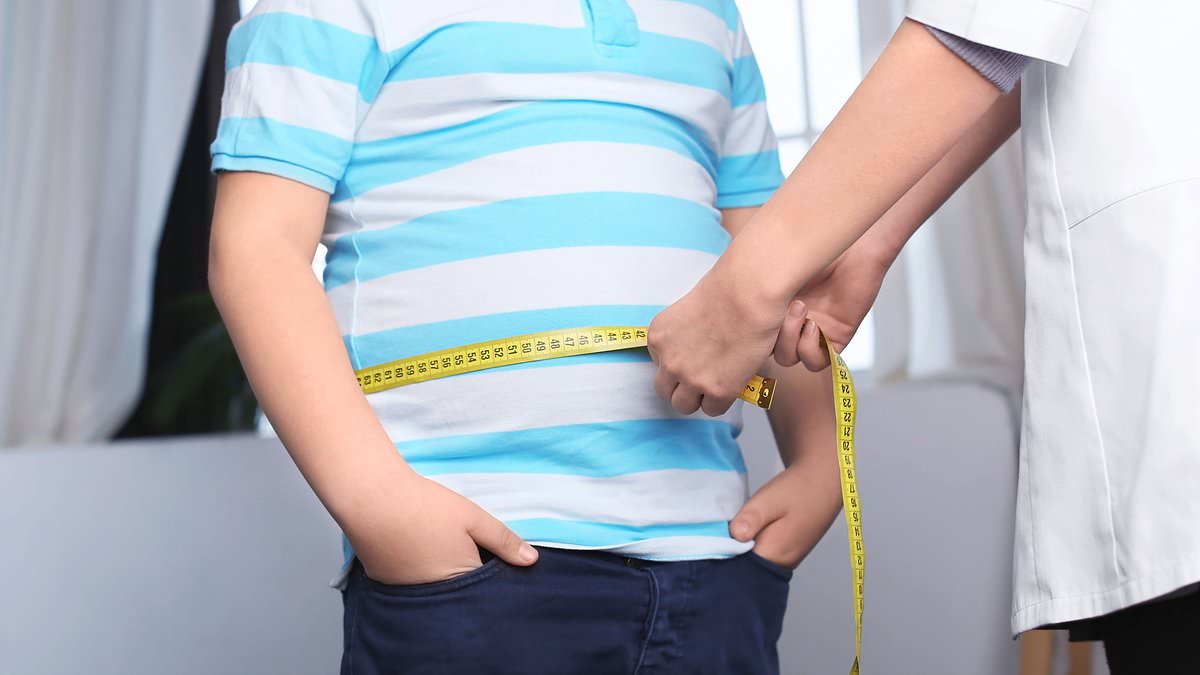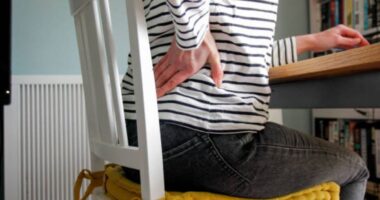England’s child obesity crisis is laid bare today in a sobering interactive map revealing the areas where kids are too heavy by the time they start secondary school.
Stark figures show 47 per cent of Year 6 pupils in Knowsley, Merseyside, are classed as either overweight or obese.
For comparison, this is nearly twice the levels logged in leafy areas such as Surrey and Richmond-upon-Thames, according to the Office for Health Improvement and Disparities.
Experts labelled this significant variation across parts of England, a ‘postcode lottery’, with the government forced to admit that Britain was in the grip of a ‘childhood obesity crisis’.
Nationally, the rate still stands at over a third — 36.6 per cent — despite having fallen slightly since Covid began.
However, this is an increase of three per cent since 2015, according to official figures.
More a million children have their height and weight measured under the National Child Measurement Programme (NCMP) every year.
Among Year 6 pupils, national obesity fell from 23.4 per cent in 2021/22 to 22.7 per cent.
Meanwhile, the proportion of youngsters deemed either overweight or obese also dipped, from 37.8 per cent to 36.6. Both measures are above pre-pandemic levels.
But when broken down by local authorities, data commissioned from the House of Commons library by the Liberal Democrats showed 47.2 per cent of Year 6 pupils were either overweight or obese in Knowsley.
This was followed by the London boroughs of Barking and Dagenham and Newham with rates of 45.7 and 45.5 per cent respectively.
Barking and Dagenham also took the obesity top spot with almost a third (31.7 per cent) of kids aged 10 to 11 classed as obese.
Outside of London, rates combining overweight and obesity stood at 45.2 per cent in Sandwell and 44.8 per cent in Wolverhampton.
In Surrey, conversely, obesity and overweight accounted for 24.9 per cent, with 25.1 per cent in Richmond-upon-Thames.
Cambridge saw the largest rise in overweight children since 2015, with a spike of almost 68 per cent in the proportion of Year 6 youngsters classed as overweight.

Over a million children had their height and weight measured under the National Child Measurement Programme (NCMP). Nationally, the rate among children in Year 6 stands at over a third, despite having fallen slightly since Covid began
Areas in Nottinghamshire also reported significant rises in childhood obesity over the past nine years, including Rushcliffe (67 per cent rise), Mansfield (65 per cent rise) and Bassetlaw (57 per cent rise).
Dr Adam Briggs, senior policy fellow at the Health Foundation, told The Times: ‘Tackling childhood obesity will require much tougher action on the marketing and sales of unhealthy food.
‘Our latest polling with Ipsos also shows there is broad public support for taxes on unhealthy food, with the revenue used to fund healthy food for low-income families.
‘Failure to invest in vital preventive services will mean worsening health and widening health inequalities, which will be felt across society and the economy.’
Childhood obesity has been a growing issue for years, with easy access to fast food, more screen time and sedentary lifestyles blamed for spiralling rates in some parts of the UK.
The NCMP, responsible for today’s data, was established in state-funded schools in England in 2006 and was considered a key element of the former Government’s war on childhood obesity.
The NCMP measures the height and weight of children which are then used to generate a Body Mass Index.
This is compared to a national scale to determine whether that child is underweight, normal, overweight or obese.
But last year, researchers from Queen Mary University of London warned the programme may do more harm than good and potentially encourage eating disorders in kids.
Parents of slim children have even complained about their kids wrongly being labelled fat.
Responding to the figures today, a Department of Health and Social Care spokesman said: ‘We face a childhood obesity crisis, setting up kids for an unhealthy life and greater pressures on the NHS.
‘This government will tackle it head on.
‘We have commissioned Lord Darzi to establish the state of the nation’s health service.
‘His findings will inform our ten-year plan to radically reform the NHS and build a health service that is fit for the future and able to confront the obesity crisis head on.
‘We will shift our focus from treatment to prevention to ease the strain on the NHS and help people to live well for longer.’
Labour ministers have pledged to introduce tight restrictions on advertising junk food, alongside a ban on children being able to purchase sugary, high-caffeine energy drinks.
It comes as the World Health Organization last year also revealed 37million children under the age of five are now overweight globally — four million more than at the turn of the century.
Australia ranked second in the table of 198 countries, with 21.8 per cent of children there classified as overweight.
Britain was 22nd (11.3 per cent), while the US claimed 52nd spot (7.9 per cent).
The WHO has warned obesity globally is ‘moving in the wrong direction’ and shows ‘no immediate sign of reversion’.
Obesity doesn’t just expand waistlines but health care costs, with the NHS spending an estimated £6.1billion annually on treating weight-related disease like diabetes, heart disease and some cancers.










